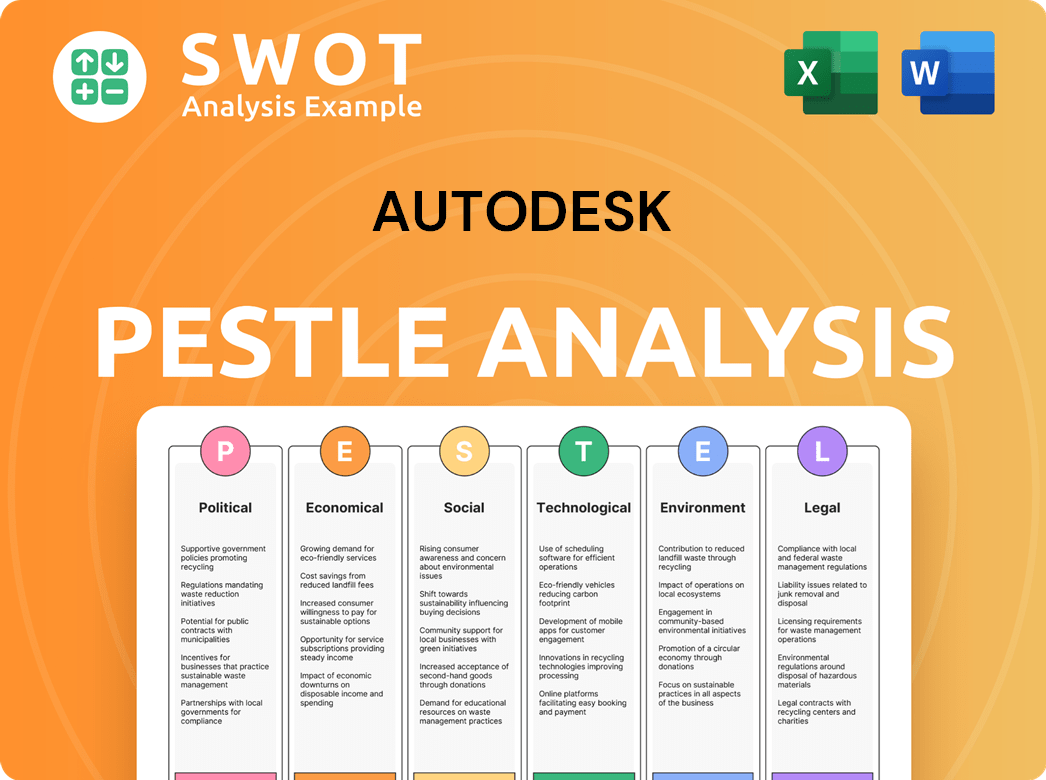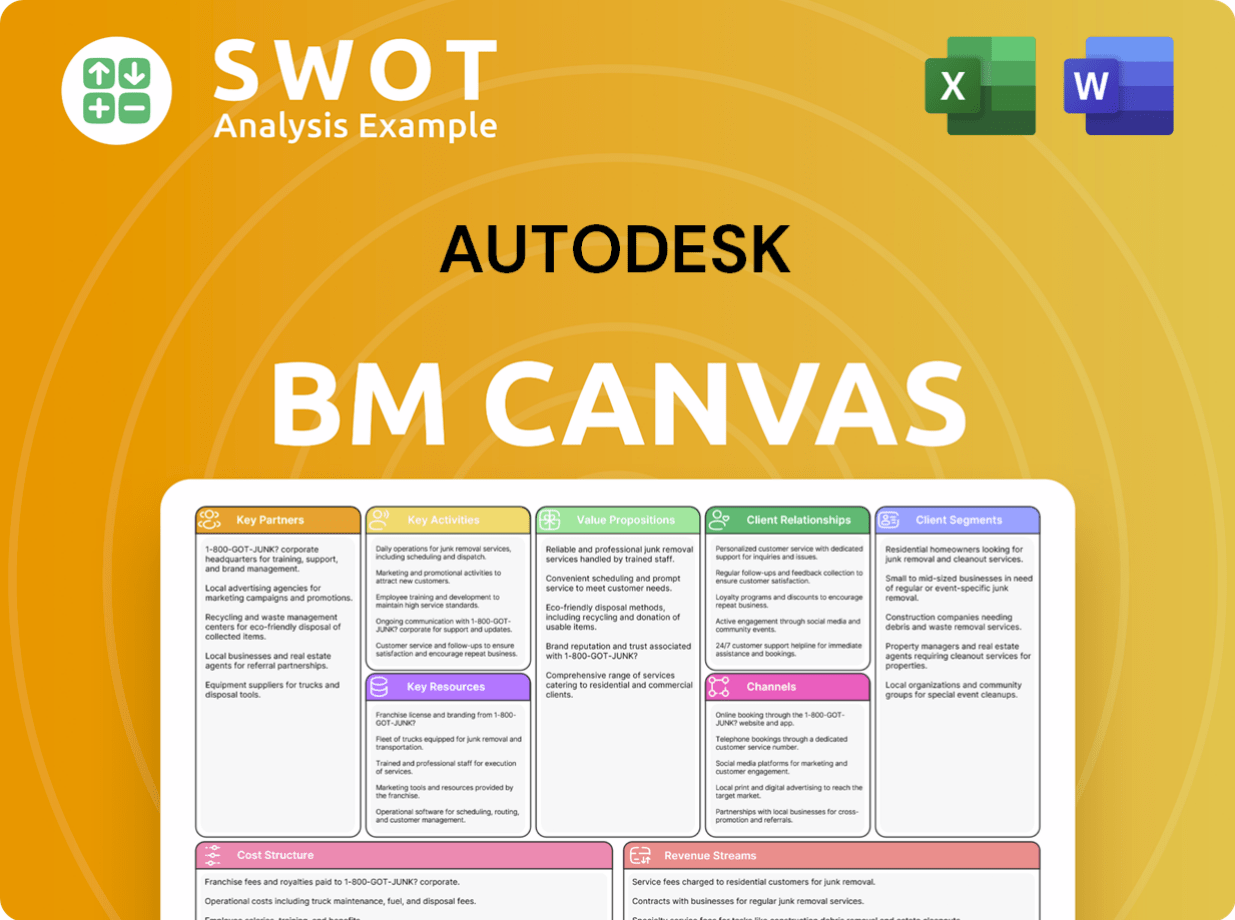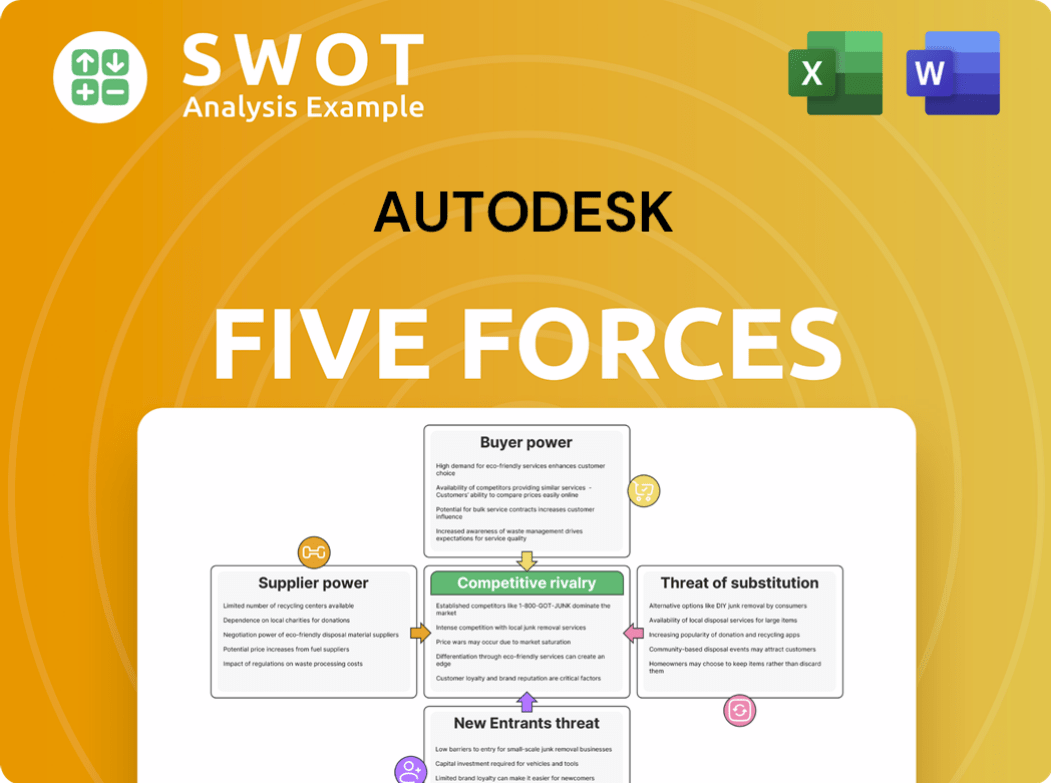Autodesk Bundle
How Did Autodesk Revolutionize Design?
Autodesk's story is one of innovation, starting with a groundbreaking idea to bring computer-aided design (CAD) to personal computers in 1982. This bold move democratized design, shifting it from exclusive mainframe systems to the desktops of architects, engineers, and creatives. This Autodesk SWOT Analysis can provide insights into their strategic positioning.

From its early years, Autodesk's journey demonstrates a commitment to innovation, transforming how industries design and create. The company's evolution, marked by significant milestones and strategic acquisitions, showcases its ability to adapt and thrive. Understanding the Autodesk history provides valuable context for its current market position and future potential. The company's mission has always been to empower designers.
What is the Autodesk Founding Story?
The story of the Autodesk company began on April 26, 1982. This date marked the official founding of the company by John Walker and his 12 co-founders. Their mission was to revolutionize the design industry.
The founders saw a gap in the market. Existing Computer-Aided Design (CAD) systems were expensive and complex. This limited their use to large corporations. The aim was to develop CAD software that could run on personal computers. This would make it affordable for individual professionals and small businesses.
The company's initial business model focused on selling perpetual licenses for its software. The launch of AutoCAD in December 1982 was a major milestone. It was a groundbreaking application for creating 2D and 3D designs on desktop computers. The name 'Autodesk' itself, a combination of 'automatic' and 'desktop,' reflected this vision. The early funding came primarily from the founders. They used their expertise and passion to bring their idea to life. The personal computer revolution of the early 1980s set the stage for Autodesk's disruptive approach.
Autodesk's founding was driven by a vision to democratize design tools.
- Founded on April 26, 1982, by John Walker and 12 co-founders.
- Identified the high cost and complexity of existing CAD systems as a key problem.
- Launched AutoCAD in December 1982, a pivotal moment in Autodesk history.
- The name 'Autodesk' reflects the goal of automating design tasks on personal computers.
Autodesk SWOT Analysis
- Complete SWOT Breakdown
- Fully Customizable
- Editable in Excel & Word
- Professional Formatting
- Investor-Ready Format

What Drove the Early Growth of Autodesk?
The early years of Autodesk were marked by rapid expansion, driven by the success of AutoCAD. This software quickly became the standard for PC-based CAD. The company capitalized on the growing power and affordability of personal computers, establishing a strong market presence by 1985.
AutoCAD's adoption was a key factor in Autodesk's early growth. The software's capabilities expanded through enhancements, attracting a growing user base. The company also began to expand its team and establish offices beyond its initial Mill Valley location, setting the stage for future growth.
A significant shift occurred in the late 1990s and early 2000s as Autodesk moved from 2D to 3D design and BIM. Acquisitions like Discreet Logic in 1999 strengthened its position in media and entertainment. The introduction of Revit in 2002, a BIM software, was a pivotal moment.
Autodesk expanded into new geographical markets, building a global presence. In fiscal year 2024, the company reported revenue growth across all major product categories. The AEC segment saw an 11% increase in revenue, and Manufacturing grew by 10%, demonstrating continued market success. If you are interested in learning more about the company, you can read about the Target Market of Autodesk.
Key milestones for Autodesk include the launch of AutoCAD and the acquisition of companies like Discreet Logic. Current Autodesk products span various industries, including architecture, engineering, construction, and manufacturing. The company's software is used for a wide range of applications, from design and modeling to simulation and analysis.
Autodesk PESTLE Analysis
- Covers All 6 PESTLE Categories
- No Research Needed – Save Hours of Work
- Built by Experts, Trusted by Consultants
- Instant Download, Ready to Use
- 100% Editable, Fully Customizable

What are the key Milestones in Autodesk history?
The Autodesk company's history is marked by significant milestones that have shaped the design and engineering software landscape. From its inception, Autodesk has consistently introduced groundbreaking products and adapted to market changes, establishing itself as a leader in its industry. The company's journey reflects a commitment to innovation and a strategic vision for the future.
| Year | Milestone |
|---|---|
| 1982 | Autodesk launches AutoCAD, revolutionizing computer-aided design (CAD) and making it accessible to a broader audience. |
| 1990s | Autodesk expands its product portfolio, introducing industry-specific software like Revit for architecture and Inventor for mechanical design. |
| 2002 | Autodesk acquires Alias, expanding its offerings in the industrial design and automotive industries. |
| 2016 | Autodesk transitions to a subscription-based business model, a significant shift in its revenue strategy. |
| 2023 | Autodesk reports strong financial results, with subscription revenue continuing to grow, demonstrating the success of its business model. |
Autodesk has consistently been at the forefront of technological advancements, driving innovation in design and engineering. The company's focus on 3D capabilities and the development of specialized software solutions have set new industry standards.
The introduction of AutoCAD in 1982 democratized CAD, making it accessible to a wider audience and transforming the design process. This marked a pivotal moment in the company's history, establishing its leadership in the CAD market.
Incorporating 3D capabilities into AutoCAD and other software solutions enhanced design visualization and analysis. This enabled engineers and designers to create more realistic and detailed models.
The development of industry-specific software, such as Revit for architecture and Inventor for mechanical design, catered to the unique needs of different sectors. This specialization enhanced productivity and collaboration.
Autodesk has expanded its offerings to include cloud-based services, such as BIM 360 and Fusion 360, to improve collaboration and accessibility. This enables users to access their designs from anywhere.
Autodesk has incorporated generative design tools into its software, allowing users to create multiple design options based on specific criteria. This accelerates the design process.
Autodesk is increasingly integrating artificial intelligence (AI) into its software to automate tasks and improve design workflows. This includes features like automated object recognition and design optimization.
Despite its successes, Autodesk has faced several challenges throughout its history. The shift to a subscription-based model and the need to adapt to market changes have required strategic adjustments.
The transition from perpetual licenses to a subscription-based model, while initially met with resistance, proved to be a successful strategy. This change provided more predictable revenue streams.
Autodesk has faced competition from other software providers, requiring continuous innovation and adaptation. The company has had to stay ahead of the curve to maintain its market position.
Economic downturns in the construction and manufacturing sectors have impacted Autodesk. The company has responded by diversifying its offerings and expanding into new markets.
Some product ventures have been less successful, prompting Autodesk to refine its offerings and focus on core strengths. This has led to strategic restructuring and product development adjustments.
Autodesk has consistently responded to evolving market demands through strategic restructuring and leadership changes. These changes have helped the company align with industry trends.
In fiscal year 2024, Autodesk reported a 10% increase in subscription revenue, demonstrating the success of its business model transformation. This growth reflects the company's strong market position.
To understand more about the financial aspects of the company, you can read about the Owners & Shareholders of Autodesk.
Autodesk Business Model Canvas
- Complete 9-Block Business Model Canvas
- Effortlessly Communicate Your Business Strategy
- Investor-Ready BMC Format
- 100% Editable and Customizable
- Clear and Structured Layout

What is the Timeline of Key Events for Autodesk?
The Autodesk company journey has been marked by significant milestones, starting with its foundation in 1982 in Mill Valley, California, and the launch of AutoCAD. The company went public in 1985 and expanded through strategic acquisitions such as Discreet Logic in 1999 and Alias in 2006. The release of Revit in 2002 marked a crucial step into Building Information Modeling (BIM), and the transition to a subscription-based licensing model was completed in 2016. Fusion 360, a cloud-based CAD/CAM/CAE tool, was introduced in 2017, and the company accelerated cloud-based offerings in 2020. In 2023, Autodesk reported strong financial results driven by subscription growth, and in fiscal year 2024, the company achieved a total revenue of $5.5 billion, reflecting a 9% year-over-year increase.
| Year | Key Event |
|---|---|
| 1982 | Autodesk was founded in Mill Valley, California, and AutoCAD was launched, marking the beginning of its journey in design software. |
| 1985 | Autodesk went public, which was a pivotal moment for the company, enabling it to secure capital for future growth and expansion. |
| 1999 | Autodesk acquired Discreet Logic, expanding its reach into the media and entertainment industry and diversifying its product portfolio. |
| 2002 | Revit, a Building Information Modeling (BIM) software, was released, which changed the architecture, engineering, and construction (AEC) industries. |
| 2006 | The acquisition of Alias strengthened Autodesk's position in industrial design, enhancing its capabilities in product design and manufacturing. |
| 2016 | Autodesk completed its transition to a subscription-based licensing model, changing its revenue model and providing users with more flexible access to its software. |
| 2017 | Fusion 360, a cloud-based CAD/CAM/CAE tool, was introduced, which made advanced design tools more accessible and collaborative. |
| 2020 | Autodesk accelerated its cloud-based offerings and digital transformation initiatives, adapting to the growing demand for cloud-based solutions. |
| 2023 | Autodesk reported strong financial results, driven by subscription growth, showcasing the success of its business model and market position. |
| 2024 | Autodesk reported a total revenue of $5.5 billion for fiscal year 2024, reflecting a 9% year-over-year increase, demonstrating continued financial growth. |
Autodesk is set to further integrate artificial intelligence (AI) into its products. This includes automating design processes and optimizing performance. The goal is to provide deeper insights to users through AI-driven tools.
Enhancing cloud-based collaboration tools is a key strategic initiative. This will improve teamwork and data sharing for users. Continued investment in the Autodesk Construction Cloud is expected.
Autodesk plans to expand its presence in emerging markets. This will help increase its global footprint. The company aims to meet the rising demand for design software worldwide.
Increased digitalization in construction and the rise of advanced manufacturing are impacting Autodesk. Demand for immersive entertainment experiences will also influence its future. Analysts predict continued growth for the company.
Autodesk Porter's Five Forces Analysis
- Covers All 5 Competitive Forces in Detail
- Structured for Consultants, Students, and Founders
- 100% Editable in Microsoft Word & Excel
- Instant Digital Download – Use Immediately
- Compatible with Mac & PC – Fully Unlocked

Related Blogs
- What is Competitive Landscape of Autodesk Company?
- What is Growth Strategy and Future Prospects of Autodesk Company?
- How Does Autodesk Company Work?
- What is Sales and Marketing Strategy of Autodesk Company?
- What is Brief History of Autodesk Company?
- Who Owns Autodesk Company?
- What is Customer Demographics and Target Market of Autodesk Company?
Disclaimer
All information, articles, and product details provided on this website are for general informational and educational purposes only. We do not claim any ownership over, nor do we intend to infringe upon, any trademarks, copyrights, logos, brand names, or other intellectual property mentioned or depicted on this site. Such intellectual property remains the property of its respective owners, and any references here are made solely for identification or informational purposes, without implying any affiliation, endorsement, or partnership.
We make no representations or warranties, express or implied, regarding the accuracy, completeness, or suitability of any content or products presented. Nothing on this website should be construed as legal, tax, investment, financial, medical, or other professional advice. In addition, no part of this site—including articles or product references—constitutes a solicitation, recommendation, endorsement, advertisement, or offer to buy or sell any securities, franchises, or other financial instruments, particularly in jurisdictions where such activity would be unlawful.
All content is of a general nature and may not address the specific circumstances of any individual or entity. It is not a substitute for professional advice or services. Any actions you take based on the information provided here are strictly at your own risk. You accept full responsibility for any decisions or outcomes arising from your use of this website and agree to release us from any liability in connection with your use of, or reliance upon, the content or products found herein.